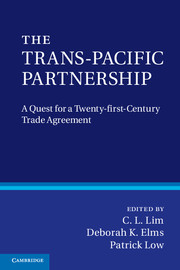Book contents
- Frontmatter
- Contents
- List of Figures and Tables
- Contributors
- Preface
- Acknowledgements
- Disclaimer
- Glossary
- Part I Introduction
- Part II The past: origins of the TPP Agreement
- Part III The present: twenty-first century elements and obstacles
- 6 Negotiations over market access in goods
- 7 TPP negotiations
- 8 Trade in services
- 9 TPP Agreement
- 10 The intellectual property chapter in the TPP
- 11 Regulatory coherence in the TPP talks
- 12 Environmental issues in the TPP
- 13 Labour standards and the TPP
- 14 What is to be done with export restrictions?
- Part IV The future: high-quality meets regional and global realities
- Part V The TPP negotiations: the quest for quality
- Index
- References
7 - TPP negotiations
rules of origin
Published online by Cambridge University Press: 05 November 2012
- Frontmatter
- Contents
- List of Figures and Tables
- Contributors
- Preface
- Acknowledgements
- Disclaimer
- Glossary
- Part I Introduction
- Part II The past: origins of the TPP Agreement
- Part III The present: twenty-first century elements and obstacles
- 6 Negotiations over market access in goods
- 7 TPP negotiations
- 8 Trade in services
- 9 TPP Agreement
- 10 The intellectual property chapter in the TPP
- 11 Regulatory coherence in the TPP talks
- 12 Environmental issues in the TPP
- 13 Labour standards and the TPP
- 14 What is to be done with export restrictions?
- Part IV The future: high-quality meets regional and global realities
- Part V The TPP negotiations: the quest for quality
- Index
- References
Summary
Introduction
Negotiations to achieve greater market access for goods under preferential trade agreements (PTAs) are not only about removing tariffs and non-tariff barriers. As PTAs are intended to grant preferential trade access to signatory partners, the PTA rules need to ensure that only the products that originate from the PTA partners will enjoy the tariff concessions, and that goods from other non-PTA countries do not enjoy the preferential market access. Hence, much importance is placed on the negotiations on rules of origin (ROO). ROOs determine the nationality of a good and ensure that only goods of PTA partners benefit from the PTA, preventing “back-dooring” of the PTA by non-parties. One of the most difficult elements in a PTA goods chapter is to develop the appropriate ROOs that guarantee that only businesses from PTA partners have access to the preferential trade concessions. The ROOs negotiations in the Trans-Pacific Partnership (TPP) are particularly difficult, as various TPP partners have different perspectives on what should be the right mix of rules to ensure that only businesses from TPP partners will benefit, and at the same time ensure that the TPP is not undermined by allowing products from non-TPP members, like the European Union or the Russian Federation, to obtain preferential market access in TPP member countries.
ROOs in PTAs determine the products that are eligible for preferential tariff treatment. Through ROOs, authorities in importing countries are able to ensure that products originating in other parties to the PTA are provided with the preferential access they are entitled to, in accordance with the PTA tariff commitments, while at the same time ensuring that goods originating outside the PTA parties are denied this preferential treatment. An analysis of the current landscape of PTAs reveals that they all have their own sets of ROOs, which in many instances differ markedly from each other. Complex ROOs make it difficult for businesses to actually enjoy the preferential access to markets provided by the PTAs. ROOs can often determine how restrictive or liberal a PTA is in practice. An important factor to take into account when negotiating the appropriate ROO is to achieve ROOs that strike a balance between the objectives of extending preferential tariff treatment only to goods originating in the parties, while ensuring that the agreement facilitates trade between the parties.
- Type
- Chapter
- Information
- The Trans-Pacific PartnershipA Quest for a Twenty-first Century Trade Agreement, pp. 121 - 132Publisher: Cambridge University PressPrint publication year: 2012
References
- 3
- Cited by

